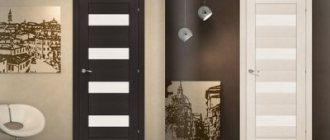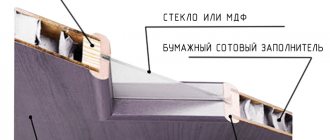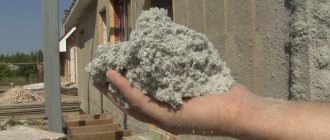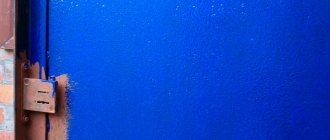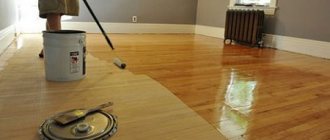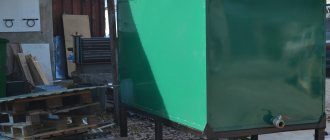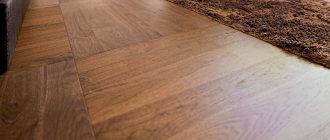With the passage of time, things often become unusable. This also applies to interior doors, which also deteriorate or have an unpresentable appearance. You can restore an old door leaf yourself in several ways. It is worth considering the type of material, degree of wear and financial capabilities. A door made of veneer can be easily confused with products made of natural wood, but the former are much lighter. Considering the manufacturing technology, restoration will not cause problems.
Painted doors
How to paint veneer doors. VENEER DOOR
An interior structure made of veneer is visually quite similar to a product made of natural wood, but their weight category differs significantly - the former are lighter in weight and also have greater functionality.
For a more detailed consideration, it is worth delving into the features of making veneered doors. Veneer is a very thin cut of valuable wood. Its purpose is based on decorative finishing of the surface of the door leaf and frame. This material is quite “capricious” and demanding, for example, in comparison with laminate. Veneer finishing gives the door textured lines and a natural shade of natural wood.
The most commonly used technique is to attach veneer to the panel structure. The method is as follows: blanks of edged or calibrated timber (preference is given to coniferous wood) are glued to an MDF (fibreboard) panel. The skeleton of such a modification is responsible for the intended geometry of the door structure, and also makes it more resistant to various negative influence factors (temperature, humidity). Using a special technological process (dynamic hot pressing method), the veneer coating is glued onto the MDF board.
Photo 2 Sequence of painting the door structure.
The sizing of the finish and base surface is carried out by heating the wood, from which the resin is released. This eliminates the need to use synthetic adhesive compounds. To ensure a glossy shine, the product is coated with several layers of varnish, with the required shade. The final color of the canvas depends on it. One batch of veneered doors, similar to those made from solid wood, has a significant difference in color, despite the fact that the manufacturer is the same.
The main reasons for this difference are considered to be the unique cut pattern of the wood and its light refractive index. The harmonization of the wood pattern is complicated by finishing with several sheets of veneer, which makes each of the models unique and original. Of course, you can choose designs that are similar in color, but the texture and pattern will vary.
In some cases, the internal structure of the canvas is filled with cardboard honeycombs, which significantly reduces its weight. Many people prefer this factor when choosing interior doors.
There are products covered with an artificial analogue of veneer - a special film. They have a 2D effect that imitates the pattern and texture of natural wood. It is quite difficult to visually distinguish such doors from a veneered structure. The advantage of such a door leaf is its increased moisture resistance.
We select the composition in order to paint correctly
The selection of paint is a priority and the required composition must be purchased before work is carried out in the required quantity.
- polyurethane paints,
- aqueous formulations - they are more convenient,
- glypthal,
- compositions for coating with paint at a decent level of moisture,
- other varieties suitable for painting veneer.
Attention! It is not recommended to use nitro paints. The problem is that such compositions react very poorly to excess moisture, which leads to the formation of dull spots on the insulated surface. Moreover, nitro paint is considered toxic and can cause poisoning.
Painting doors. Varnish
This category of materials includes compositions that are often used to consolidate the result after painting with acrylic paint or stain. Varnishes are transparent and tinted. The former are ideal for emphasizing the natural texture of wood, the latter for adding a slight shade and shine.
Varnish is used not only for decorative purposes; it is necessary when the surface of a wooden product needs to be protected from external adverse factors.
There are several types of varnish:
- Alkyd. Just like paint from this group, it creates a durable coating that is resistant to temperature fluctuations and has water-repellent properties.
- Acrylic. The material is resistant to high humidity and does not deteriorate under the influence of ultraviolet rays. It has no pungent odor and comes in glossy or matte finishes.
- Nitrocellulose. Painting interior doors with this composition is possible only in dry rooms with an optimal microclimate, since the resulting coating does not have sufficient strength and can quickly crack.
- Polyurethane. It has good adhesion to wooden surfaces and is characterized by the strength and durability of the coating. Available in glossy, semi-gloss and matte. Not only doors, but also veneer, countertops and even parquet can be coated with this varnish.
- Polyester. It has high strength and wear resistance, but is toxic. It has a strong chemical odor, so it is best used to cover outdoor doors.
Further care
It is worth using interior doors carefully, keeping them clean, and avoiding mechanical damage. There is a list of products that do not need to be applied to this door leaf:
- hard abrasives;
- liquid cleaners containing active chemical components;
- iron scrapers.
With proper care, the door leaf will look beautiful for a long time.
How to paint dark doors light. Preparing for coloring
Before you start painting, remove the door from its hinges. In the event that you only need to slightly update the paint layer, this is not necessary. Painting doors in an apartment with your own hands begins with preparing the workplace. The door removed from its hinges is laid horizontally on suitable supports at a height of at least 50 cm from the floor. Ordinary stools are successfully used as supports, on which boards the width of the door leaf are placed. The supports must be covered with a non-slip, lint-free, dense fabric. The door is processed first on one side, then turned over to the other. The first stage of work is removing the layer of old paint. For convenience, all fittings (handles, hinges, etc.) are first removed, and a small amount of cotton wool or rags is placed in the holes. To remove a layer of old paint, use a solvent, a stiff wire brush or sandpaper.
After removing the paint, level the surface of the interior door, fill the cracks with putty, polish the surface with a grinding machine or fine-grained sandpaper and apply a layer of primer. The primer is prepared from the same paint that will later be used to paint the main background. To prepare it, the finished paint is diluted with a solvent in a ratio of 1:3. The resulting composition is used to prime the canvas in 1 layer. If necessary, after priming, it is putty again, partially or completely. All of the above applies to interior doors made of wood. When preparing to paint doors made from other materials, there are some important points to keep in mind:
- It is enough to remove the top layer of varnish from a veneer door. If you only need to slightly update the gloss, then the paint is applied over the previous coating;
- Only the top layer of waxy dirt-repellent impregnation is removed from the laminate canvas;
- doors made of MDF and chipboard are prepared for painting in the same way as wooden doors.
When the remnants of the old paint have been removed from the door and its surface is prepared for the application of new paint, begin painting. To paint a wooden door in an apartment, it is most convenient to use a roller, and to work on small details and protrusions, use a small brush. It is convenient to use a special spray gun to apply paint. This is especially true in the case of painting a door made of MDF. Before applying the paint, it is recommended to carefully filter it: this will make the coating more dense and uniform.
Important! The door leaf is painted only in one direction! You cannot put layers of paint towards each other. During work, avoid direct sunlight on the door leaf. The room must be protected from dust and midges, which, sticking to fresh paint, will ruin the job.
If you want to varnish the surface, be sure to wait until the paint layer has completely dried. This process takes a day for acrylic paints and two to three days for alkyd enamels.
Required tools and materials
Tools for painting veneered doors
To paint a veneered door with high quality, there is no need to purchase expensive equipment. In most cases, everything you need can be found in your home pantry.
To work you will need:
- rubber spatula;
- stationery knife;
- sandpaper;
- wash;
- brush;
- roller;
- spray gun or spray gun;
- square;
- primer;
- final paint coating.
The specifics of the upcoming activity should be taken into account. It must be performed in protective glasses, gloves, a respirator, and in conditions of high-quality ventilation of the room.
How to paint faux veneer doors. How and with what to paint a veneer door
First of all, you need to decide for yourself whether to paint the door completely or leave the color of the natural solid wood. The choice of restoration method depends on how damaged the veneer surface is. If there are few defects and they are represented by shallow scratches, you can get by with regular varnishing, and then thoroughly rub the surface with polish. Small scratches are quite easy to remove; all you need to do is use a varnish of the desired shade.
However, sometimes it happens that after purchasing a veneered door, it turns out that its color does not quite meet expectations, since it does not suit the interior of the room. What can be done in this case? If the canvas is completely new (it has not been used), it can be varnished in a different tone without removing the previous layer of varnish. Floor coverings do an excellent job with this task, but not furniture ones.
The old layer of varnish is removed with fine sandpaper or using a special varnish remover. In this case, a grinding machine cannot be used, since due to the high speed of operation, indentations will appear on the surface of the door and the thin veneer coating will be hopelessly damaged.
If the color of a veneered door needs to be changed radically (damage to the surface is very noticeable at first glance at a considerable distance), you need to prepare to perform some additional work. The algorithm of actions in this case consists of surface preparation and application of paint and varnish material. All work on the surface of natural veneer should be carried out with the utmost care - it is very easy to damage due to its microscopic thickness. If you do not have the necessary skills and experience, it is better to entrust such work to professionals.
The surface for painting is prepared by gradually stripping it of the previous layer of varnish and simultaneously removing dirt and dust. Next, you need to cover up all the unevenness with a layer of special primer. A door coated with veneer can be repainted with polyurethane, glypthal or water-based paint.
You cannot use nitro paint, as unsightly matte spots may appear on the surface of the veneer. The most suitable option for veneer is water-based paint. Before you start painting the door, you need to wait until the primer is completely dry.
Theoretically, you could also paint a faux veneer door. However, this is quite difficult to do in practice, since it is unlikely that you will be able to choose a paint that will not roll off the smooth surface of the film and will not damage it. And if the film is first coated with a layer of primer, this will destroy the effect of natural wood.
There is another way to make a truly high-quality restoration of an artificial veneer door. This is an important point that must be taken into account if you happen to buy just such a model along with an apartment.
We consider it necessary to remind you once again - before you start painting a veneer door, you need to decide how important it will be to completely change the appearance of the product, and what is better to use - paint or varnish. If you try to change the surface layer using chemical dyes, you can ruin the environmental friendliness of the door. A simple consultation with a competent veneer door specialist can solve many questions.
DIY painting steps
Painting the door should be carried out according to an algorithm that includes several stages:
- Removing a layer of old varnish or previous coating by treating the door with a soap solution and a solvent used for paint. If necessary, you can use sandpaper (you can do without removing the base layer if the coated canvas is not damaged).
- Puttying with a special solution, which you can make yourself by mixing sawdust in PVA glue. After drying, you need to sand the surface with sandpaper.
- Painting begins with the panel, making even brush strokes along the fibers, after which the recesses and ends are treated.
- After the first painting of an interior door in an apartment, the coating will seem to be applied unevenly, so a second application of paint is used after sanding the first layer.
- Before painting the door frame, apply masking tape to the wallpaper adjacent to it to protect its surface.
It is better to carry out self-painting work with the canvas removed from the hinges. Before starting, you need to inspect it for any irregularities, which are repaired with a special primer.
In most cases, veneered doors have a certain pattern, so painting with a spray gun is quite complicated and should be done by professionals. The choice of paint is determined by the old coating and available financial resources. The best option is to use acrylic enamel, which gives a matte finish to the surfaces. But she's expensive. When using it, it should be taken into account that it must be secured with a reinforcing coating.
When painting doors made of artificial materials, it is better to turn to professionals, because due to paint running off the canvas, poor-quality painting may occur.
Actions in case of minor errors in operation
You can fix minor scratches or chips yourself. Select a transparent furniture varnish or wax furniture polish. If the area of damage is small, only this surface is painted over. If an area with chips or scratches is visible at a distance of 1 m, then you need to paint the entire canvas to eliminate shine.
Small nuances of the process
To paint a veneer door, you need to use a not very concentrated paint, because the higher its concentration, the more the design will be hidden. When painting, adhere to the following rules:
- To preserve the texture and pattern, colored varnishes are used (you can choose a varnish taking into account the required matte finish);
- to add brightness and richness to the canvas, you need to use a stain, which is best applied with a spray bottle, but can be applied with a sponge or brush;
- surface treatment is carried out in a horizontal plane;
- It is better to paint it in different shades.
When using a brush, it can leave streaks and drips, so you need to fluff it up and remove loose and fallen hairs. To smooth out unevenness, you need to brush along and across the canvas.
When painting a door white, it must be cleaned so that no dust or dirt remains. The question often arises of what to do with the places where door handles are attached. They need to be removed because the areas underneath need to be primed and impregnated.
The very first
So, let's get down to the most important thing - preparing the furniture for painting. It is necessary to stock up on materials and tools for work.
- As a means of removing old paint, we recommend using paint remover from wood. You can buy it at a car store. It perfectly removes old coating in just a few minutes. The wash has a gel-like consistency, adheres well and does not spread over the surface. When working with the remover, it is recommended to use a respirator. Another way to remove the old coating is to traditionally sand the surface using an emery sponge or a sander. The smooth texture of veneer is initially even and smooth, and as a result of processing, the surface may lose its glossy shine, so when painting veneer, you should clearly consider what kind of surface you need: matte or glossy. To give a glossy shine, the veneer should be finished with a finishing layer of varnish.
- Prepare a small spatula and a medium-hard metal brush. A spatula will be needed to remove the old coating from a wide surface, and a small metal brush will be needed to remove paint from the sides and corners.
- Velor roller, synthetic brush. You can easily find these tools at any hardware store. When applying acrylic paint, craftsmen advise using a synthetic brush, which is sold in an art store. Unlike a traditional construction brush, it “fits” better and leaves no marks.
- You will need aids such as an emery sponge, gloves, and sanding equipment if available.
- Now you need to remove all the fittings, remove the locks, handles, if it is a chest of drawers or a sideboard, remove the drawers, shelves, remove the doors from the hinges (find out more information on how to paint a chest of drawers).
It is important to thoroughly clean the surface of the furniture to be painted.
Individualities
Veneer is a cheap, eco-friendly material made from wood sheets up to 1 centimeter wide. In the manufacture of furniture, doors and other structures, veneer sheets are glued to a strong and dense wood base, which is usually used as chipboard and fiberboard (MDF). Veneer has the texture, visual appeal and qualities of natural wood.
Its implementation makes it possible to produce cheap and lightweight structures (furniture, interior doors, floor coverings), which are visually virtually indistinguishable from products made from solid wood.
At the same time, the thinness and fragility of the veneer plates cause its fragility and vulnerability to water and mechanical damage. Taking into account these individualities, primary and re-staining, as well as surface treatment of veneered products, are carried out with the greatest care. Negligent and inaccurate actions when working with veneer can lead to damage to the material, the appearance of cracks, deep scratches and chips on its surface.
Looseness is another characteristic feature of veneer that distinguishes it from solid wood. This feature causes increased consumption of paints and varnishes when working with veneered surfaces. This aspect should also be taken into account when planning to paint veneered structures at home.
Coloring veneered products requires preparatory work. The individuality and stages of their implementation depend on the initial state of the structure, the type and thickness of the old paintwork, the nature and depth of existing damage.
Step by step process
To begin with, it must be said that this process is quite complex and tedious. At the same time, it requires the availability of certain materials, the price of which is sometimes very high. That is why, before embarking on it, you need to carefully weigh everything in order to make the right decision.
Sample of material to determine its qualities and get an idea of the appearance of the final product
Paint selection
- First of all, it must be said that fire-retardant paints for metal Polistil are used in such situations only in cases where it is necessary to restore fittings that come into contact with hot objects. It is usually found in furniture that is used to decorate the kitchen. For other metal parts, it is better to use a cheaper dye.
Special compounds are used for varnished surfaces. which in their composition are closer to varnishes or enamels
- If the question is asked whether it is possible to paint veneered furniture, then in this case professional painters and carpenters answer in the affirmative, however, they believe that it is better and much easier to replace the coating itself, since it will look more beautiful and more practical. Otherwise, you should use water-based acrylic dyes. They will give the surface a good color and will not hide the veneer structure.
- When the question comes about whether it is possible to paint polished furniture, some experts answer in the negative. However, if you use special transparent enamels or varnishes, you can not only apply the necessary layer over the old surface, but also carry out a kind of restoration by rubbing out scratches and then polishing.
Using ordinary oil materials to create artistic painting on an already treated surface
- Quite often there is a need to paint furniture white. Therefore, first, putty is usually used, which is applied to the prepared surface, and then acrylic dye is applied. The result is an almost perfectly smooth coating that will look great in any type of interior.
There is simply a huge selection of different materials that allow you to imitate other types of surfaces
- Sometimes there is a desire to give some furniture elements a silvery metallic color, but sputtering or chrome plating cannot be done. Therefore, electrically conductive paint Zinga or similar is often used for such situations. It allows you to achieve the desired result at low cost.
Advice! It is believed that you can paint wooden furniture with almost any paint. However, she will not always get a good appearance, and not every material will serve her well. Therefore, professional craftsmen recommend using special compounds that were developed for these purposes.
Before starting work, it is worth protecting those areas of the furniture that you do not plan to apply dye to.
Step by step process
- When choosing what to paint polished furniture with, you must take into account that almost any coating requires a prepared surface. That is why they immediately purchase primer and putty.
- It is best to clean any surface. Fine abrasive sandpaper is perfect for this. At the same time, professional craftsmen strongly recommend removing the old coating, since it can cause the paint to lag behind the surface.
It is much easier to first disassemble the furniture and process each part separately to achieve maximum results
- The next step is priming. If it is necessary to preserve the fibrous structure of the wood, the restoration instructions recommend using a minimal amount of primer or using transparent types. Some experts believe that it is enough to simply treat areas of chips, cracks or other damage, but this opinion is wrong, since the primer increases adhesion and reduces the degree of absorption of the surface.
Removing old coating using a special tool
- Putty is applied to furniture in a thin layer to preserve the fiber structure. However, there are times when it is necessary to obtain a smooth coating. Then they use several layers of this material, which, after drying, is rubbed down with their own hands using sandpaper and coated again with a primer.
- Professional craftsmen recommend completely disassembling the necessary piece of furniture before starting work. This will allow you to subsequently replace all connecting elements and fittings, which will significantly increase its service life. In this case, you can add additional elements to the design or decorate the facade with decorative elements.
Some types of paints are quite toxic, which means it is best to use personal protective equipment when working with them.
- It is recommended to use the dye only when the wood is completely dry. At the same time, it is applied in several layers using a sprayer so that they are uniform. (See also the article Types of finishes: features.)
Advice! Professional craftsmen recommend first testing the chosen technique and material on a small piece of the object that is hidden from view. This way you can see the end result and understand the need for certain actions.
Using a sprayer will make the job much easier and save paint.
We paint old furniture white or give life to unnecessary things
Often an old chest of drawers, chair, table or cabinet made of solid wood is very dear to us, like a memory. It’s a shame to throw them away, and they no longer fit into the new interior. Therefore, the task is to update it. How to paint furniture at home?
I suggest the most elegant, fresh color is white. Painting furniture is a great way to extend the life of old furnishings and equipment and give them new life.
For example, white distressed furniture can be finished in such a way that it looks very stylish. You will need to process the furniture in two stages:
- whitening;
- light sanding with sandpaper.
Wooden products made from solid wood are best suited for this purpose: oak, pine, birch, beech.
To work you should prepare:
- dark dye and white acrylic paint or two colors of acrylic paints;
- white wax candles;
- brushes;
- coarse and fine-grained sandpaper;
- textile;
- knife.
- Clean the surface of the chest of drawers or chair from dust, wipe it several times with a damp cloth and leave until completely dry.
- If the surface is painted, you need to remove the varnish layer with sandpaper (first coarse and then fine-grained).
- Places that you want to highlight: carved decorations, slats, edges, should be covered with darker paint (brown and blue shades are ideal here). Leave the paint to dry.
- To get an uneven and natural effect of worn corners, wax the areas previously painted with dark paint. The wax will make it so that the next coat of paint will not adhere tightly to these areas.
- Cover the entire surface with white paint, preferably several times, with breaks to dry. Avoid stains.
6. Areas covered with an additional layer of paint and wax should be rubbed with a knife. Don't press too hard - this way you will get a good effect.
7. Rub the entire surface with fine sandpaper to level the surface.
Whitening with whitening paste
Bleaching using a bleaching paste consists of rubbing the wood with a special paste containing wax and pigment. The wood surface will develop distinctive white lines, making it look older. Porous wood is suitable for such bleaching - trees such as oak and ash.
You need to buy in the store:
- special paste,
- prepare paint in the chosen color,
- metal brush,
- hard brush,
- textile,
- a piece of coarse and fine-grained sandpaper.
- Wipe the clean surface of a chair or chest of drawers from dust several times with a damp cloth and leave until dry.
- If the surface is painted, you need to remove the varnish layer with sandpaper.
- Paint the surface with paint and let it dry.
- Using a wire brush on the wood, make tiny grooves according to the grain orientation.
- Apply the whitening paste, fill the grooves well and wait for the paste to dry.
- Wipe the surface with a dry cloth.
- Cover the surface with varnish.
Express whitening
If you want to give a simple wooden stool new life, you can do it with a washed-off white paint effect. Nothing could be simpler.
- sandpaper,
- White paint,
- varnish,
- brush.
- Rub the wooden surface with sandpaper.
- Using a brush, apply a coat of paint.
- When the paint dries, remove excess paint with a napkin.
- Coat the wood with varnish.
How to repaint lacquered furniture? Yes, just like repainting polished furniture and any other furniture. The only problem is old, cracked varnish or polish. It can be removed in several ways:
- The mechanical method is the cheapest and most accessible , but also the longest and most labor-intensive. Old polishing or varnishing is removed using sandpaper or a sandpaper. Once you select it, don’t forget to wear safety glasses to prevent dust and small pieces from getting into your eyes.
- The chemical method is quite expensive ; it involves special chemicals applied to the old surface and then washed off with water. They come in the form of powder, gel, foam, etc. When removing old varnish using this method, you need to protect the skin and mucous membranes.
- The thermal method removes the old coating using a hair dryer . Heating the surface with one hand, scrape off the polish or varnish with the other. With this method, you need to be careful with temperatures to avoid ignition.
Below are photos of painted furniture:
Another option for white furniture. You can decorate with artistic drawings.
If you liked the article, please like it)) Thanks in advance.
What composition should I use?
The choice of varnishes is huge. The compositions are classified into several groups according to the type of base. To choose a paint coating, use the following tips:
- A good option is varnish for interior work. If there is high humidity in the room, then it is better to choose paints and varnishes for outdoor use.
- Pay attention to resistance to sudden temperature fluctuations.
- Consider the interior style. For example, matte varnish is suitable for Provence style rooms.
- Surface quality. When varnishing interior doors, gloss will make defects and unevenness more visible, while matte will disguise it.
Next, popular paints and varnishes, their advantages, features and disadvantages will be considered. Which varnish to choose is decided by the person himself, based on personal wishes and financial capabilities.
Alkyd
The varnishes are made with solvents; interior doors will have an off-white, rather yellowish tint.
Advantages:
- strength;
- moisture resistance;
- quick drying;
- acceptable price.
Minuses:
- unpleasant pungent odor;
- rapid fading in the sun;
- contains harmful substances.
Nitrovarnishes
Acetone and nitrogen compounds act as a base. The substance is transparent and can preserve the natural shade of wood. However, nitro varnish cannot be used in living rooms.
Pros:
- low price;
- strength;
- durability;
- short drying time - up to 1 hour.
Flaws:
Polyurethane
The basis is polymers with long molecules. When coated, this varnish changes the shade of interior doors to a darker one.
Advantages:
But polyurethane varnish is applied only to a previously prepared primer layer.
Acrylic
Manufactured on a water basis. Eco-friendly, suitable for use in living rooms.
Pros:
- quick drying due to water evaporation;
- resistance to sunlight;
- mechanical damage.
General information
Of course, before you get acquainted with the technology, first of all you should figure out what paint to paint the furniture with, because the result of the work will largely depend on the choice of paint composition. True, it’s impossible to name just one type of paint coating, since it all depends on the furniture itself and what you want it to look like in the end .
First of all, the paint must be selected in accordance with the type of coating, i.e. Wooden furniture requires wood coatings, and metal products require metal coatings. In some cases, the paint also has requirements such as water resistance, frost resistance, etc.
For the rest, you should rely on your own preferences, for example, the coverage could be:
- Glyantsev;
- Matt;
- Transparent (varnish compositions).
Furniture paint
Sometimes passive fire protection of furniture is required, in which case its surfaces are coated with fire-retardant paints. Moreover, it is necessary to treat not only wooden parts with a fire retardant composition, but also metal parts, for which fire-retardant paints for metal Polistil or their analogues can be used.
Advice! When it comes to painting metal garden furniture, the most important requirement for paint is protection against corrosion. In this case, a proven product is electrically conductive paint Zinga, which provides two-level protection - barrier (passive) and cathodic (active), as with cold galvanizing.
It should also be said that for different types of furniture not only different painting compositions are used, but also different painting technologies are used. Moreover, many of them have fundamental differences.
What will you need for work?
Has the glossy surface lost its distinctive shine, dulled and lost its original appearance? Then you need to take care of painting the aged piece of furniture. To do this, you just need to apply a new coating. Let's start with what materials and tools you will need:
- acrylic based paint;
- glossy or matte varnish;
- roller and brush for applying paint;
- scraper and metal brush to remove the old layer of varnish;
- sandpaper (or sanding machine);
- primer solution (for repainting wood surfaces);
- solvent and detergent;
- protective composition for wood (antiseptic).
Is it possible to renew previously coated wooden door structures?
Only veneer sheets or wooden doors made of:
There are cases when the old varnish coating is worn out and damaged. There is no point in using paint here. It is better to apply a varnish composition, but of a darker shade.
New coating:
- disguises cracks, chips, traces of mold and mildew;
- will prevent the appearance of insects, putrefactive formations, and unpleasant odors (especially in the bathroom).
Very often people change the varnish layer when the room is undergoing renovation. This allows you to get doors in the same style as the entire interior.
Useful tips from the experts
To eliminate defects and errors when varnishing an interior door, follow the recommendations of the craftsmen:
- Use masking or paper tape. Wrap the product around door handles and other fittings. This will protect the elements from varnish and construction mixtures. Regular tape is prohibited. It will leave traces that are then impossible to get rid of.
- Choose mixtures and varnishes from the same manufacturer. Don’t forget about a trial application of paintwork.
- It is better to get rid of the old protective layer. This has a positive effect on the final appearance of the door and will extend its service life.
- Don't forget about safety precautions. Perform work wearing protective gloves. If your skin becomes irritated, wear protective clothing.
- Ventilate the room.
- After finishing work, allow the door to dry thoroughly: do not touch or load.
On doors made of birch, oak and pine, varnish is applied generously so that the surface is thoroughly saturated. Remove any remaining paint with a brush and acetone. It is better to protect the floor surface and other interior elements with rags, tape or paper to save time on cleaning the room.
It's easy to varnish interior doors. The process does not require a person to have deep knowledge in the painting field. It is enough to arm yourself with tools, choose the right building mixtures and paints, and properly prepare the work surface. Advice from the experts will help you approach each stage more professionally.
